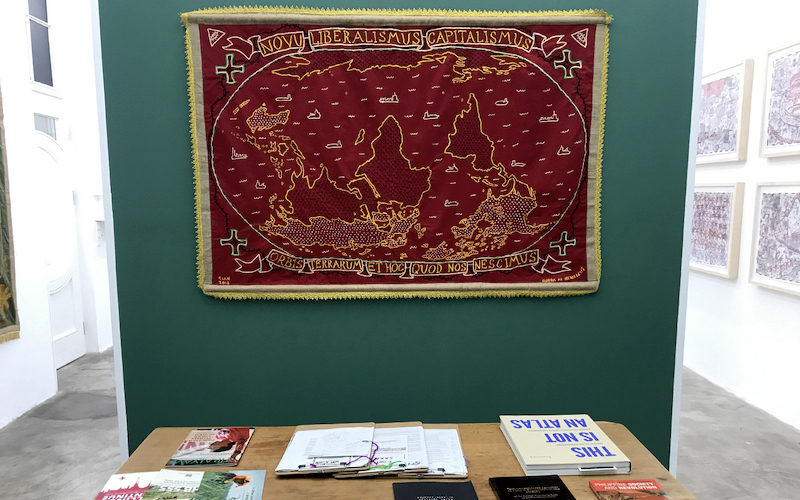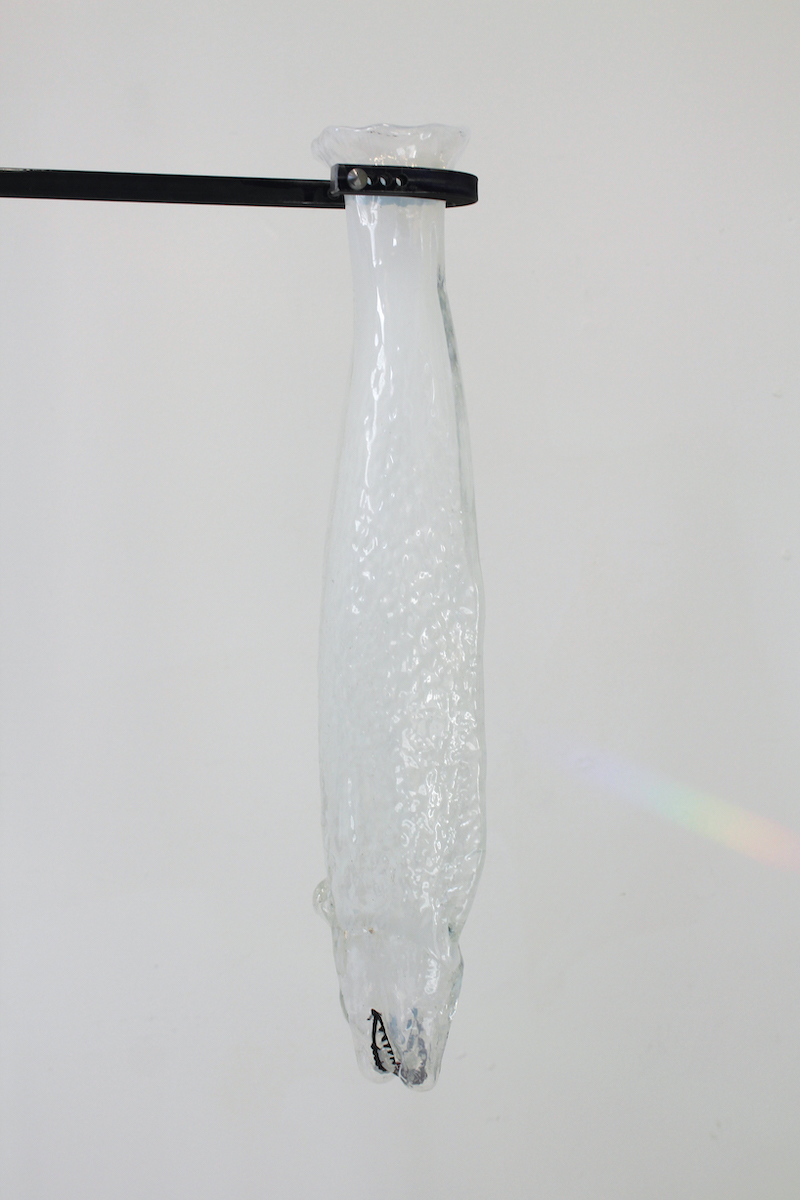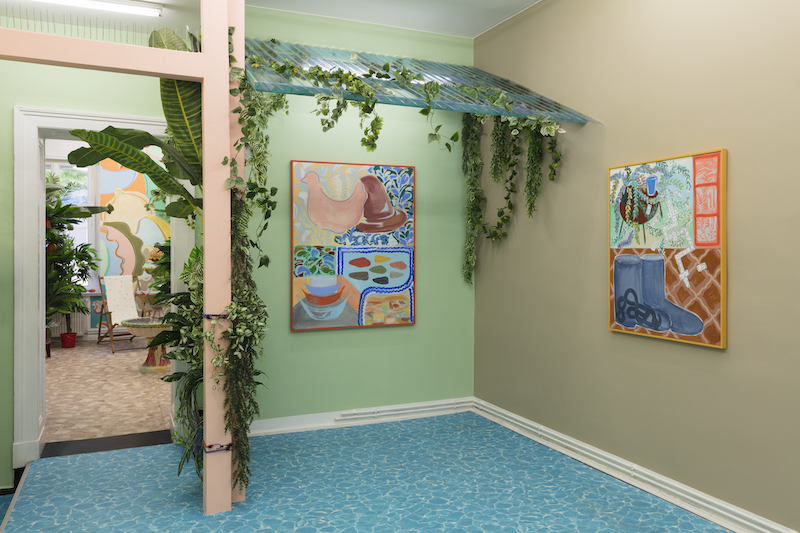Article by Johanna Hardt // Apr. 28, 2019
With the ambitious plan to check as many galleries off the list as possible, I cycle into Gallery Weekend early Friday afternoon. From a cloudless sky, the sun is beating down mercilessly, making me wish I was wearing shorts instead of all black. I wait for my companion and together we venture forth into the galleries’ cold interiors. From Alexander Levy, hosting sculptures and photographs by artist Fabian Knecht, to Nigel Cooke’s large-scale paintings presented by Buchmann Galerie, to artist Anne-Mie Van Kerckhoven represented by Barbara Thumm Gallery, we finally arrive at carlier | gebauer, where we, not without reason, linger the longest.
While my eyes are still adjusting to the light that seems to reflect from both the walls as well as the bright objects in the space, a sharp, recurring noise makes me cringe. Due to its regularity, I shrug it off as some technical error in the gallery. The main exhibition space I enter is vast, with three monumental sculptures occupying the walls. Slowly approaching the casts of Gröting’s recent series ‘Berlin Fassaden’ (2016–2018), I start to notice more and more details on their surfaces. Dotted with bullet holes, these silicone casts are the facades of public buildings damaged by the Second World War. What has been impressed on these walls we find here reversed, discovering visibility through inversion. Holes inside the walls of a building are like scars that mark your face: repetitious reminders of vulnerability and fear. While urban renewal attempts to fill those architectural structures, Gröting’s casts position themselves critically against Germany’s attempts to get rid of those remnants of the war. As a protest against forgetting, Görting’s negatives manage to capture the lapse of time almost like a slow exposure: from the shot of the bullet, to its entry wound, to the dirt and sand-dust, finding a place over the years.
On the floor of the gallery are her ‘Reclining Figures’. Unlike the revealing, body-exposing art historical figures, Gröting’s white wax- and epoxy-resin cast sleeping bags take on a weird cocoon-like shape, hiding instead of exposing the human form. Impressed by the first room, I excitedly go on to the second room. The sculpture ‘Verdauungswege 2’ (1990), that lies across the floor, looks exactly like its title suggests: a digestive organ. Taking something from the body’s inside, this sculpture creates an interesting contrast to the ones before. The video screened in the next room allows a comparison to the notion of slowness evoked by ‘Fassaden’, while adding a comical note. In Gröting’s latest video, ‘Things’, mundane items such as a banana, or a glove, are sailing into a blue sky, slowing making their way back down and out of the frame. Just before I leave, I notice what was causing the strange noise I heard walking in. In the middle of a tiny hole drilled into the gallery wall two wires are reacting to each other with strikes of blue lighting. It’s another unexpected work by Gröting.

Installation View: Cian Dayrit, ‘Beyond the God’s Eye’, Nome Gallery, 2019 // Courtesy of NOME Gallery
From this highlight, we move on to Lindenstraße where we find, next door to one another, KOW, who invites us to a hands-on exploration of objects from Franz Erhard Walther’s ‘First Work Set’ (1963–69), and Gallery Taik Persons, who is showing a selection of photographs and videos by Elina Brotherus, which depict her with and in front of the camera. But it’s not until later in the night that I find exhibited works to catch my interest in the same way that Gröting’s exhibition did earlier in the day. In ‘Beyond the God’s Eye’, NOME Gallery presents Cian Dayrit’s first solo show in Europe. The practise of the Filipino multimedia artist investigates colonialism and ethnography, archaeology, history and mythology. Through embroidery and textiles and painted over collages of colonial era maps, Dayrit approaches a panoptic technology that assists imperial powers in governance, discipline and control, while enacting counter-cartography as a means of emancipatory activity. The second room in the gallery shows the results of a workshop the artist held with rural, urban and indigenous communities in his native Philippines. The workshop centred on map-drawing: fostering a visualisation of alternative territories. The visual display of the workshop’s results, which is accompanied by other documentation and further resources about the artist’s work, is there for visitors to explore, which I encourage everyone to do.

Installation View: Cian Dayrit, ‘Beyond the God’s Eye’, Nome Gallery, 2019 // Courtesy of NOME Gallery
From there, I catch the openings at Soy Capitan, Klemm’s and ChertLüdde. After having interviewed Brooklyn-based artist Elizabeth Jaeger earlier in the month, I’m especially looking forward to getting a glimpse of her transparent glass fish. Dangling upside down from steel structures, the fish are based on the idea of lachrimonies, vessels believed to hold tears of mourning people, and inspired by fish vessels dating back the 2nd Century BC. Seeing them in real life, the fish seem more fragile, more sleek. Installed at different heights, the sculptures in their steel constructions evoke an interesting engagement with their viewers; visitors approach them, visibly amused by the tiny, sharp, drawn on teeth of the fish, bending down, looking inside the fish that allows a view into its hollow interior.

Elizabeth Jaeger: ‘Fish’, 2018, glass and copper, sculptures on steel structure, various sizes // Courtesy of the artist and Galerie Klemm’s
As a last stop, Sol Calero at ChertLüdde makes a strong contrast to the sleek design of Jaeger’s work shown in Klemm’s brightly lit space. I carefully make my way up into Calero’s immersive installation, trying neither to step on the mangos on the floor, nor accidentally bump into the crowd that surrounds me. Dangling from the ceiling, the leafs of green plants are brushing against my head while I make my way through the room. The walls are covered with fruit and leaves in warm, pastel colours, incorporating elements of style commonly excluded from western narratives. As a tribute to her late grandmother Luisa Hernandez, described as a pillar of the family, the exhibition remembers her house as a space where art and craftsmanship were not separated, but integrated deeply in collective means of art-making and understanding.

Sol Calero: ‘Archivos Olvidados’, installation view at ChertLüdde, Berlin // Courtesy the artist and ChertLüdde, Berlin, photo by Andrea Rossetti
Exhibition Info
CARLIER | GEBAUER
Asta Gröting: ‘Not feeling too cheerful: reclining figures, facades and more’
Exhibition: Apr. 27–June 01, 2019
Markgrafenstraße 67, 10969 Berlin, click here for map
NOME
Cian Dayrit: ‘Beyond the God’s Eye’
Exhibition: Apr. 27–June 12, 2019
Glogauer Straße 17, 10999 Berlin, click here for map
KLEMM’S
Elizabeth Jaeger: ‘Brine’
Exhibition: Apr. 26–June 08, 2019
Prinzessinnenstraße 29, 10969 Berlin, click here for map
CHERTLÜDDE
Sol Calero: ‘Archivos Olvidados’
Group Show: ‘Conglomerate’ TV Network
Juan Antonio Olivares: ‘Vespula Vulgaris’ (BUNGALOW)
Exhibition: Apr. 26–June 15, 2019
Ritterstraße 2a, 10969 Berlin, click here for map



















